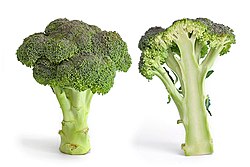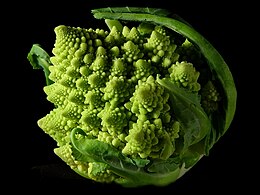| Broccoli |
|---|
 Broccoli |
| Species |
| Brassica oleracea |
| Cultivar group |
| Italica Group |
| Origin |
| From Italy (2,000 years ago)[1][2] |
Contents
|
General
The word broccoli, from the Italian plural of broccolo, refers to "the flowering top of a cabbage".[3]Broccoli is classified in the Italica cultivar group of the species Brassica oleracea. Broccoli has large flower heads, usually green in color, arranged in a tree-like fashion on branches sprouting from a thick, edible stalk. The mass of flower heads is surrounded by leaves. Broccoli most closely resembles cauliflower, which is a different cultivar group of the same species.
History
Broccoli evolved from a wild cabbage plant on the continent of Europe. Indications point to the vegetable's being known 2,000 years ago.[4] Since the Roman Empire, broccoli has been considered a uniquely valuable food among Italians.[5] Broccoli was grown at Antwerp whence it was taken to England by the sculptor Peter Scheemakers, according to a biographical note by J. T. Smith.[6] Broccoli was first introduced to the United States by Italian immigrants but did not become widely known until the 1920s.[4]Culinary
Broccoli is usually boiled or steamed, but may be eaten raw and has become popular as a raw vegetable in hors d'œuvre trays. Boiling reduces the levels of suspected anti-cancer compounds in broccoli, with losses of 20 – 30% after five minutes, 40 – 50% after ten minutes, and 77% after thirty minutes.[7] However, other preparation methods such as steaming, microwaving, and stir frying had no significant effect on the compounds.[7] Steaming broccoli for 3–4 minutes is recommended to maximize potential anti-cancer compounds, such as sulforaphane.[8]Nutritional and medicinal
| Nutritional value per 100 g (3.5 oz) | |
|---|---|
| Energy | 141 kJ (34 kcal) |
| Carbohydrates | 6.64 g |
| Sugars | 1.7 g |
| Dietary fibre | 2.6 g |
| Fat | 0.37 g |
| Protein | 2.82 g |
| Water | 89.30 g |
| Vitamin A equiv. | 31 μg (3%) |
| - beta-carotene | 361 μg (3%) |
| - lutein and zeaxanthin | 1121 μg |
| Thiamine (Vit. B1) | 0.071 mg (5%) |
| Riboflavin (Vit. B2) | 0.117 mg (8%) |
| Niacin (Vit. B3) | 0.639 mg (4%) |
| Pantothenic acid (B5) | 0.573 mg (11%) |
| Vitamin B6 | 0.175 mg (13%) |
| Folate (Vit. B9) | 63 μg (16%) |
| Vitamin C | 89.2 mg (149%) |
| Vitamin E | 0.78 mg (5%) |
| Calcium | 47 mg (5%) |
| Iron | 0.73 mg (6%) |
| Magnesium | 21 mg (6%) |
| Phosphorus | 66 mg (9%) |
| Potassium | 316 mg (7%) |
| Zinc | 0.41 mg (4%) |
| Percentages are relative to US recommendations for adults. Source: USDA Nutrient database | |
A high intake of broccoli has been found to reduce the risk of aggressive prostate cancer.[16] Broccoli consumption has also been shown to be beneficial in the prevention of heart disease.[17]
See also Broccoli sprouts for possible health/medical benefits.
Varieties
There are three commonly grown types of broccoli. The most familiar is a often referred to simply as "broccoli", and sometimes calabrese named after Calabria in Italy. It has large (10 to 20 cm) green heads and thick stalks. It is a cool season annual crop.Sprouting broccoli has a larger number of heads with many thin stalks. It is planted in May to be harvested during the winter or early the following year in temperate climates. The heirloom variety "calabrese" available in North America is of this type.
Romanesco broccoli has a distinctive fractal appearance of its heads, and is yellow-green in colour. It is technically in the Botrytis (cauliflower) cultivar group.
Purple cauliflower is a type of broccoli sold in southern Italy, Spain, and the United Kingdom. It has a head shaped like cauliflower, but consisting of tiny flower buds. It sometimes, but not always, has a purple cast to the tips of the flower buds.
Orange cauliflower, green cauliflower and purple cauliflower have also been produced through selective breeding.
Other cultivar groups of Brassica oleracea include cabbage (Capitata Group), cauliflower (Botrytis Group), kale and collard greens (Acephala Group), kohlrabi (Gongylodes Group), and Brussels sprouts (Gemmifera Group). Chinese broccoli (Alboglabra Group) is also a cultivar group of Brassica oleracea.[18]
Production

Cauliflower and broccoli output in 2005
| Top ten cauliflowers and broccoli producers—11 June 2008 | ||
|---|---|---|
| Country | Production (tonnes) | Footnote |
| 8,585,000 | F | |
| 5,014,500 | ||
| 1,240,710 | ||
| 450,100 | ||
| 433,252 | ||
| 370,000 | F | |
| 305,000 | F | |
| 277,200 | ||
| 209,000 | F | |
| 186,400 | ||
| World | 19,107,751 | |
| No symbol = official figure, F = FAO estimate Source: Food And Agricultural Organization of United Nations: Economic And Social Department: The Statistical Division | ||
Cultivation
Broccoli is a cool-weather crop that does poorly in hot summer weather. Broccoli grows best when exposed to an average daily temperature between 18 and 23 °C (64 and 73 °F).[19] When the cluster of flowers, also referred to as a "head" of broccoli, appear in the center of the plant, the cluster is green. Garden pruners or shears are used to cut the head about an inch from the tip. Broccoli should be cultivated before the flowers on the head bloom bright yellow.[20]Gallery
| Close-ups of broccoli florets | Sicilian Purple Broccoli | A leaf of a Broccoli plant | |
| Broccoli flowers | Romanesco broccoli, showing fractal forms | Broccoli in flower | Steamed broccoli |








No comments:
Post a Comment